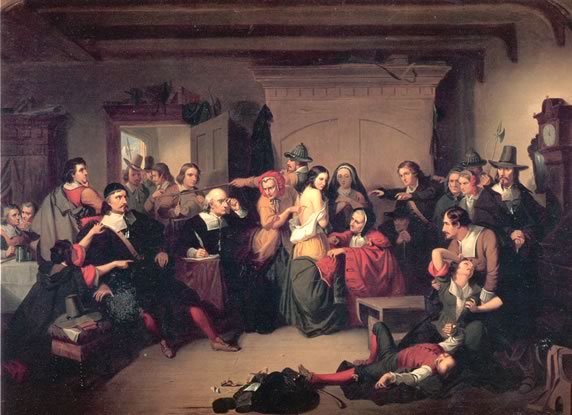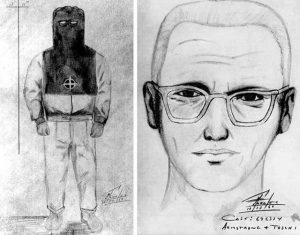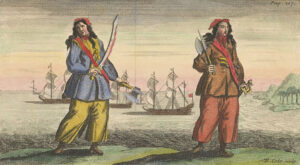Why would adults in Salem, Massachusetts in the 1690s take the accusations of nine year old girls seriously? During the seventeenth century, New England had grown diverse. The people living in the communities were of different backgrounds. But in the 1690’s there was an apparent outbreak of witchcraft. The most famous of these outbreaks was the event in Salem, Massachusetts in 1692 that stirred up the Salem community and soon spread to other communities.
The widespread hysteria over witches was all over the town after an accusation of witchcraft was made in January 1692. A group of young adolescent girls met in the home of Samuel Parris, a Puritan pastor in Salem. The pastor had a nine year old daughter, Betty. Betty and her cousin Abigail were fascinated by the voodoo tales and tricks told to them by the family slave. The family slave, Tituba, was the one whom the little girls had sought after for entertainment.1 It was not long after their time spent with Tituba, when the girls began to behave strangely; seeing visions, babbling at times, and lapsing into trances. The Puritans thought that these behaviors were of witchcraft, as the work of the devil. People in Salem began believing the girls, and charged Tituba and two other village women for practicing witchcraft on them. Two men, John Hathorne and Johnathan Corwin of Massachusetts, were called to do a legal examination of the women. The Puritans followed the Old Testament law. This was how they assessed the examinations. Scripture had a statement that said witches were not able to live. The two men knew exactly what they had to do. The examination was done on these women of Salem by looking for a certain mark on the body: a wart or tit. This specific mark was said to be the place where the devil and his demons would take blood out of the witch.2 Many of the women accused were of lower status in the community.

Research shows most of the accused witches were middle-aged women, widowed, with few or no children. Also, if the woman had been involved with domestic conflicts, they were accused. The women were accused of crimes and appeared to be dangerous by their neighbors. Women in Salem who inherited or possessed land were also accused of witchcraft.3 The accusations towards these women were out of the ordinary and seemingly wrong. One must first think about the view of women during this time. They were undermined and portrayed as having no power or knowledge of such things; they were subservient to the men in the community. Not only were low class women accused of witchcraft, but as time passed, superior women were accused as well.4
On October 29th, the Salem Witch Trials were called to an end. Governor Phips dismissed the Court and that marked the end to the witch hunt craze. Many were disappointed about the ending of the trials, but many were glad to return to work.5 The community in Salem blamed Pastor Parris for letting the innocent die. The people of the Salem church also voted to void his salary. In the following years, those family members of the deceased were restored their good names. The families were awarded a compensation for all the financial loses they went through during such tragic times. Increase Mather, a pastor of the Boston Puritan Church, wanted the people to do away with the court because he believed they put innocent people to death.
The Witch trials took on an important role in American History. The trials became a tragic and memorable moment in history. Generational, racial, and sexual hostility, opposition to law, social stresses, and food poisoning were all causes as to why the people had anxieties that found release in the witch hunt craze. The witch hunts became searches for scapegoats; the community leaders were looking for anyway possible to ease the community’s anxieties.6
- Kenneth P. Minkema, “In the Devil’s Snare: The Salem Witchcraft Crisis of 1692,” The Christian Century, no. 8 (2003): 37. ↵
- Salem Press Encyclopedia, January 2015, s.v. “Salem Witchcraft Trials,” by Warren M. Billings and Kimberly Manning. ↵
- Alan Brinkley, American History, 15th ed., vol. 1: to 1865 (2 Penn Plaza, New York, NY 10121: McGraw Hill Education, 2015), 86-87. ↵
- Salem Press Encyclopedia, January 2015 s.v. “Salem Witchcraft Trials,” by Warren M. Billings, Kimberly Manning. ↵
- Salem Press Encyclopedia, January 2015 s.v. “Salem Witchcraft Trials,” by Warren M. Billings, Kimberly Manning. ↵
- Salem Press Encyclopedia, January 2015 s.v. “Salem Witchcraft Trials,” by Warren M. Billings and Kimberly Manning. ↵



178 comments
Alyssa Leos
This was a well written article! I was taught about the Salem Witch Trials before, but I was never really interested or really grasped the information, but this article really helped me understand the trials. It’s sad how women of low class and high class/superior women were also accused of being something they weren’t. Also sad how some lost their lives and their families had to live with that pain. This was a very informational article!
Jace Nicolet
Salem witch trials
This reading is very interesting because we can see nowadays that witches aren’t real but back then it was a real problem that took many lives. In the town of Salem, some middle aged women were being accused for being witches and therefore sentenced to death. This was a big problem because there was no real way of proving that someone is a witch so with this also came controversy.
This is related to what I am learning in class because not only is it in the same years and colonies, but it also has the factor of religion and rights in the article. Even the Salem church blamed the pastor for letting people die and religion ties into a big chunk of the new land.
This article is very well written and it does a good job at keeping my interest up throughout the whole story. There are great pictures provided to make the reader feel a sense of community and be able to experience what the setting was like back then. She also uses real live examples to give the reader a connection kwith the person effected like 9 year old Betty.
Victoria Cantu
This article was captivating! Short but informative. One thing that caught my attention was the section where the author spoke about the legal examinations that took place and how the puritans justified these actions based on the old testament law. I find it fascinating how throughout times of history, the norm for many things fluctuates. The idea they had about legal examinations and how specific marks were said to be where the devil and his demons would take blood out of the witch is absurd. I understand that they had some reasoning in their logic to rationalize why they made these decisions, using the bible. Still, like many, I will never comprehend how they made such inhumane measures. Overall, great storyline and personal details!
Guadalupe Altamira
The title was really eye-catching and made me want to read it. I was aware that many people were killed just because of the circumstances of their life at home like being widowed or having no kids. They probably didn’t think about the women like what if they couldn’t have children or if their children died, it definitely made it hard for those women to deal with their losses.
Laura Poole
I have watched a play over the Salem Witch Trials and this article sums it up pretty nicely. The sexism is so evident in this story and I think it is important to point that out. Women were targeted and prosecuted for basically nothing yet men were seen as somehow immune to witchcraft? This is also a great historical reminder that panicking can lead to greater disasters! Great article, it was fun to read.
Courtney Mcclellan
The question at the beginning of the article really draws in the readers. The reference to the disappointment of some people help highlight that the trials were forms of entertainment for some people. The article uses very clear diction and the image that is used helps the reader understand the aggression of accusations from one person to the other.
Alexandra Camarena
I found this article very informative. While I’ve always heard of the Salem Witch Trials, I didn’t know that they were started by a small group of girls. I loved the way the author started her article because it had a very good hook, which draws the reader in more. While this event may not seem like an important part of history, it serves of a reminder that we need to take a step back and evaluate before acting. If the town had evaluated the problem before acting maybe innocent lives could’ve been saved.
Alia Hernandez Daraiseh
This was a very well written article, and I am fascinated by this story. It angers me how many women have passed due to false accusations of young girls, but it is nice to know where this whole thing started out. It is crazy to me how not just women of lower statuses were affected, but also women of high statuses as well. This has intrigued me to read more about this story, great work!
Kenneth Cruz
The article you wrote was very interesting Oscar. I always enjoy learning about the Salem Witch trials. I feel like it is mentioned in almost every history class. It has gain so much popularity in the media through movies, books, and scholarly articles like these. You really went into depth on how it affected women at the time and the injustices they endured.
Dylan Vargas
I like the story that was written, it shows the start of the conflict with Tituba and the eventual end of the trails and everything that happened in-between. Showing how the women of these conflicts and accusations dealed with them and why they were killed. The reasons being that they were women at the time were men ruled with an Iron Fist. They didn’t have the rights and couldn’t even defend themselves which is pretty sad to note. All around the article was well put together like the end they showed what happen because or the responses of the trails and the end of them.